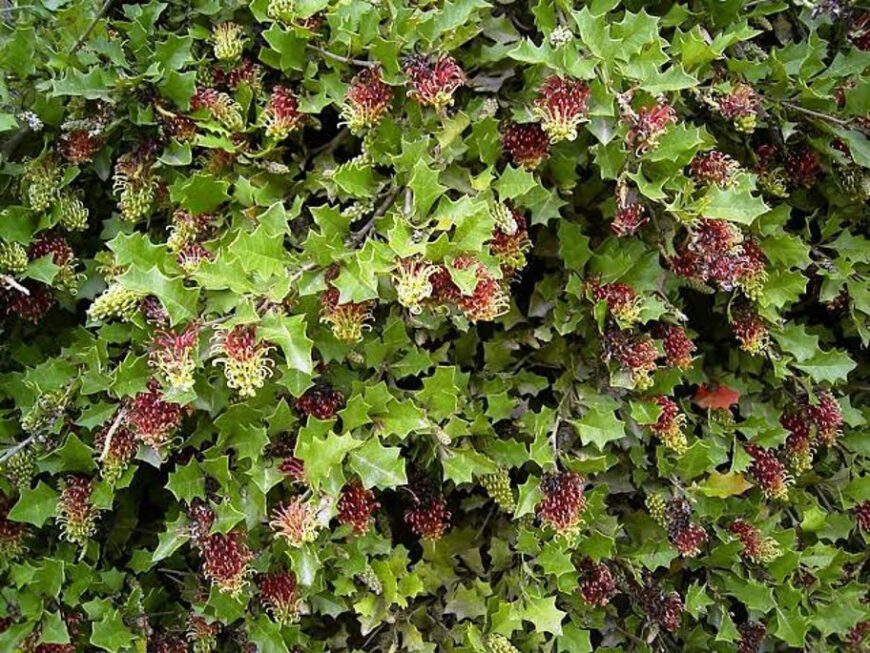PARK WATCH Article June 2025 |
Neil Marriott takes a look at some of western Victoria’s lesser-known endangered holly-leaf grevilleas
Western Victoria is a biodiversity hot-spot for ‘holly-leaf grevilleas’ – those plants that have slightly to deeply divided leaves that look superficially like English Holly. The geology of the region has allowed isolated pockets of bushland and mountain ranges to rapidly evolve a host of unique plants. Sadly, nearly all are under extreme threat, and with the onset of climate change this is becoming worse and worse by the year. Let’s look at some of these and the threats they face.
Mt Cole Grevillea (Grevillea montis-cole)
This beautiful grevillea is totally confined to the Mt Cole Range between Beaufort and Ararat, and the entire population of mature plants was destroyed by the horrific bushfire in February 2024. Fortunately, a good number of seedlings have germinated since the fire, so Parks Victoria and DEECA have fenced out the best areas for recovery. This has proven to be essential in the face of threats from feral deer and rabbits.
Enfield Grevillea (Grevillea bedggoodiana)
Confined to the Enfield State Park south of Ballarat, Enfield Grevillea was never a common plant. In the wild it presents as a most attractive ground cover or low, spreading shrub; size is to 0.3m tall and up to several metres wide.
Sadly, and despite many warnings, Forest Fire Management Victoria trialled a technique of fire-break creation using a powerful mulching machine which totally pulverises everything in its path – this included over 30 large and healthy grevilleas, all of which were wiped out.
Ben Major Grevillea (Grevillea floripendula)
This wonderful plants is found exclusively growing on the lower slopes of Mt Ben Major and around the Musical Gully Flora Reserve in the hills just north of Beaufort.
Interestingly, the Ben Major Grevillea is highly variable in habit, from semi prostrate to an upright shrub to 0.6m. Its pendulous toothbrush flowers range from bright red to yellow all the way through to green and black, while its holly leaves can be grey-green or bright green and can vary from almost entire to deeply divided! This genetic diversity means the Ben Major Grevillea is under greater threat from fragmentation: the loss of even one or two populations can mean the total loss of that genetically distinct form.
Tragically, many populations have suffered from severe die-back as a result of Grevillea Leaf Miner infestations and over-zealous controlled burns. Climate change may be the last straw, as many young plants are now dying out before they have had the chance to flower and set seed. Although it may be too late for this beautiful plant in the wild, fortunately Cranbourne Botanic Gardens and the Grevillea Study Group have numerous plants in cultivation. Of course this will never be as good as preserving the plants in the wild.
Mt Langi Ghiran Grevillea (Grevillea brevistyla)
Formerly known as Grevillea montis-cole ssp brevistyla, this beautiful, but extremely rare grevillea is in fact a new species, following DNA research carried out by Gareth Holmes in 2014. Sadly, the most abundant population amongst granite boulders on the top of Mt Langi Ghiran has completely died out as our climate dries.
Growing in shallow soils, it relied on regular rain and cloud cover to maintain soil moisture levels. This plant is rapidly heading towards extinction, although another population has been discovered by my wife Wendy and myself at a lower altitude and in a more sheltered location.
- Read the latest full edition of Park Watch magazine
- Subscribe to keep up-to-date about this and other nature issues in Victoria
- Become a member to receive Park Watch magazine in print

